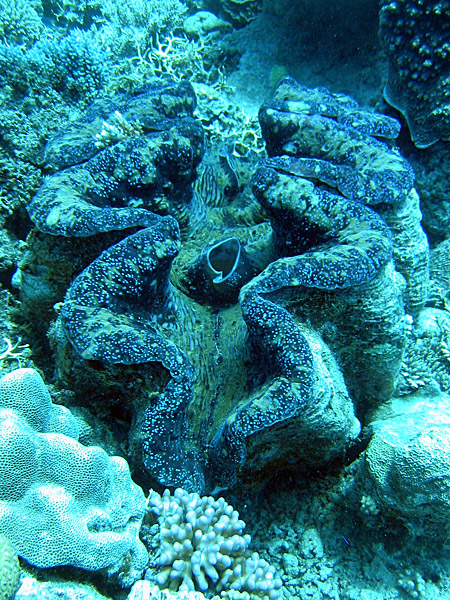Giant Clam (Tridacna gigas) - Wiki Giant clam
From Wikipedia, the free encyclopedia
Order: Veneroida
Family: Tridacnidae
[Photo] Giant Clam (Tridacna gigas). Photographed by Jan Derk (http://commons.wikimedia.org/wiki/User:Janderk) in November 2002 on the Great Barrier Reef, Australia. Released into the public domain by the author.
The giant clam or taklobo, Tridacna gigas, or traditionally, pa’ua, is the largest living bivalve mollusc. One of a number of large clam species native to the shallow coral reefs of the South Pacific and Indian oceans, they can weigh more than 227 kilograms (500 pounds) and measure as much as 1.2 metres (4 feet) across, and have an average lifespan in the wild of 100 years or more.
Sessile in adulthood, the creature's mantle tissues act as a habitat for the symbiotic single-celled dinoflagellate algae (zooxanthellae) from which it gets its nutrition. By day, the clam spreads out its mantle tissue so that the algae receive the sunlight they need to photosynthesize.
History and Legend
As is often the case with uncharacteristically large species, the giant clam has been historically misunderstood. Known in times past as the killer clam or man-eating clam, reputable scientific and technical manuals once claimed that the great mollusc had caused deaths; versions of the U.S. Navy Diving Manual even gave detailed instructions for releasing oneself from its grasp by severing the adductor muscles used to close its shell.
In a colorful account about the discovery of Pearl of Lao Tzu, Wilburn Cobb claims that a Dyak diver drowned by the tridacna closing its shell on his arm.
Today, it is generally acknowledged that the giant clam is neither aggressive nor particularly dangerous. While it is certainly capable of holding one fast in its grip, the shell's closing action is actually a defensive response, and too slow to pose a serious threat.
Conservation status
The IUCN lists the giant clams as vulnerable. There is concern among conservationists for the sustainability of practices among those who use the animal as a source of livelihood. The numbers in the wild have been greatly reduced by extensive overharvesting for food and the aquarium trade. On the black market, giant clam shells are sold as decorative accoutrements, and the meat, called Himejako in Japan, is prized as a delicacy.
http://en.wikipedia.org/wiki/Giant_clam
| The text in this page is based on the copyrighted Wikipedia article shown in above URL. It is used under the GNU Free Documentation License. You may redistribute it, verbatim or modified, providing that you comply with the terms of the GFDL. |
